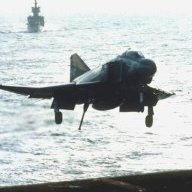Here's one in the "modern" category ( I guess 50 years old is modern), and probably only unusual by todays standards.
It's a GE CF-700, one of the early aft fan designs, which were a simple way to develop a turbofan from an existing turbojet.
It's based on a J-85 turbojet as the core engine ( used in the F-5, Cessna Dragonfly etc.) A separate single stage low pressure turbine and fan, as one wheel unit, was mounted aft of the existing J-85 two stage turbine. This fan/turbine unit had no mechanical connection to the core engine and was driven aerodynamically by exhausting gases.
Original J-85 with 2 stage turbine driving 8 stage compressor.
[ATTACH=full]1519[/ATTACH]
CF-700 with the addition of the free wheeling aft fan assembly.
[ATTACH=full]1520[/ATTACH]
It was used in the Dassault Falcon, Sabreliner, and the lunar landing simulators.The idea was eventually dropped in favour of the modern front fan design, due to problems with the large temperature variation between the turbine and fan materials, with the central turbine running much hotter than the outer fan blade tips.
A similar aft fan engine design was developed from the J-79 turbojet (F-4 Phantom, Starfighter etc.) and powered the Convair Coronado.
Another design unusual for it's use of both radial and axial compressors combined is the two spool Garrett TFE 731, relatively new at 40 years old, powering Lear jets, Cessna Citations, Dassault Falcons etc..
At the rear of the engine, a three stage low pressure turbine drives a four stage LP compressor and geared fan at the front. Central to the engine, a single stage high pressure turbine drives a single stage HP centrifugal compressor.
[ATTACH=full]1527[/ATTACH]
[ATTACH=full]1523[/ATTACH] [ATTACH=full]1524[/ATTACH]
Cheers, Willie.
[ATTACH]18324[/ATTACH]



